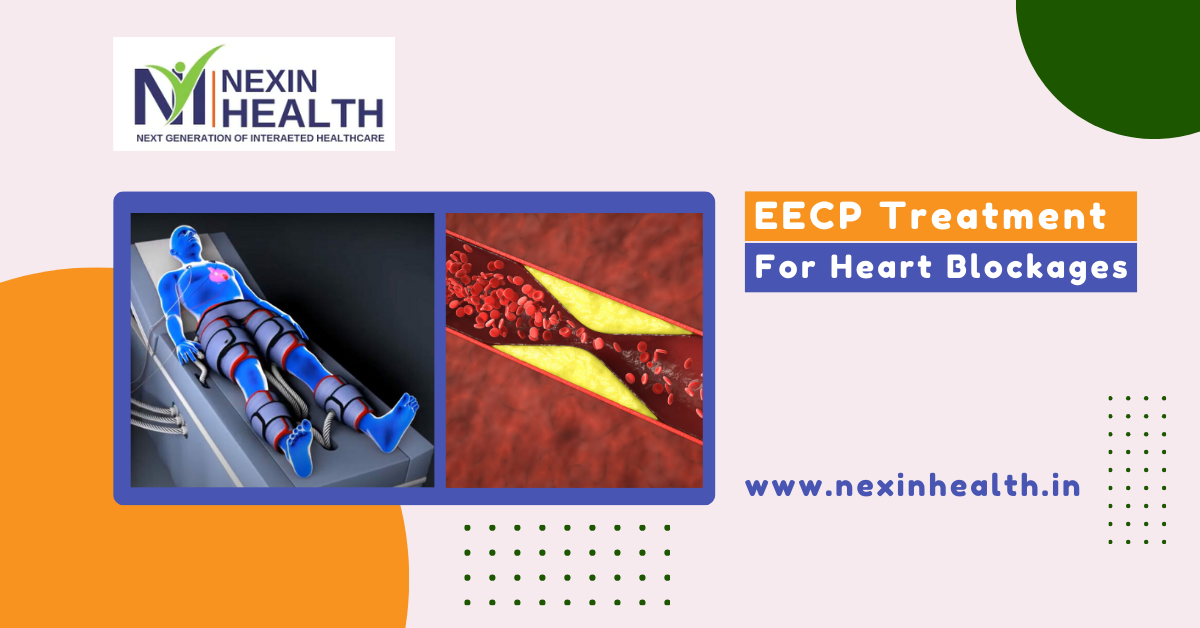EECP Therapy for Heart Blockages


EECP Therapy for Atherosclerosis (Heart Blockages): A Non-Surgical Treatment to Clear Arteries
Atherosclerosis is a progressive disease characterized by the buildup of plaque—composed of fat, cholesterol, calcium, and other substances—in the arteries. This condition leads to the narrowing and hardening of the arteries, restricting blood flow to vital organs. As a result, atherosclerosis significantly increases the risk of serious cardiovascular events, including heart attacks and strokes. While traditional treatments often involve surgical interventions such as angioplasty or bypass surgery, Enhanced External Counterpulsation (EECP) therapy offers a promising, non-invasive alternative for managing atherosclerosis and promoting arterial health.
In this blog, we will explore how EECP therapy works to address atherosclerosis, its benefits for patients, and the clinical evidence supporting its effectiveness.
Understanding Atherosclerosis
Atherosclerosis is often referred to as a “silent” disease, as it can develop over many years without noticeable symptoms. The process begins with damage to the inner lining of the arteries, often due to risk factors such as:
As plaque accumulates, it can restrict blood flow and lead to:
The primary goal of treatment for atherosclerosis is to improve blood flow and reduce the risk of serious cardiovascular events.
Traditional Treatments for Atherosclerosis
Traditional approaches to managing atherosclerosis often include:
While these treatments can be effective, they often come with risks, especially surgical procedures. Moreover, they may not fully address the underlying factors contributing to atherosclerosis.
What is EECP Therapy?
Enhanced External Counterpulsation (EECP) therapy is a non-invasive treatment designed to improve blood flow to the heart and enhance overall cardiovascular health. The therapy involves wrapping inflatable cuffs around the legs, thighs, and buttocks, which inflate and deflate in sync with the patient’s heartbeat. This process increases venous return (the amount of blood returning to the heart) and encourages the development of collateral vessels (natural bypasses around blocked arteries).
EECP therapy typically consists of 35 one-hour sessions, spread over seven weeks, and is performed on an outpatient basis. The treatment has been FDA-approved for conditions such as chronic angina and heart failure, and emerging research suggests it can also benefit patients with atherosclerosis.
How EECP Therapy Works to Address Atherosclerosis
EECP therapy offers several mechanisms that help manage atherosclerosis and improve overall arterial function:
EECP therapy enhances blood flow to the heart and other vital organs by increasing venous return during diastole (the relaxation phase of the heart). The cuffs inflate in a coordinated manner, pushing blood back to the heart, which helps:
As arteries become narrowed or blocked due to plaque buildup, the body can develop new blood vessels (collateral vessels) to bypass these blockages. EECP therapy stimulates the growth of these vessels, allowing blood to flow more freely and reducing the impact of arterial blockages. This helps:
The endothelium is the inner lining of blood vessels, and its health is critical for maintaining proper vascular function. In patients with atherosclerosis, endothelial function can be impaired, leading to increased plaque formation and vascular stiffness. EECP therapy improves endothelial function by stimulating the release of nitric oxide, which helps:
Chronic inflammation plays a significant role in the progression of atherosclerosis. EECP therapy has been shown to lower inflammatory markers, such as C-reactive protein (CRP) and high-sensitivity CRP (hs-CRP), which are associated with cardiovascular disease. By reducing inflammation, EECP therapy helps:
Clinical Trials Supporting EECP Therapy for Atherosclerosis
Several clinical studies have demonstrated the effectiveness of EECP therapy in managing atherosclerosis and improving cardiovascular health:
The MUST-EECP trial evaluated the effectiveness of EECP therapy in patients with chronic angina. The results showed significant improvements in exercise tolerance, quality of life, and reduced angina episodes among participants.
The PEECH trial focused on the impact of EECP therapy on patients with heart failure and ischemic heart disease. Findings indicated that patients experienced improved ejection fraction, increased exercise capacity, and reduced hospitalizations for heart failure complications.
The IEPR collects data from patients who undergo EECP therapy across multiple centers worldwide. This ongoing registry has shown that EECP therapy effectively reduces symptoms of atherosclerosis and improves overall cardiovascular health, resulting in fewer hospital visits and lower healthcare costs for patients.
Comparing EECP Therapy to Traditional Treatments for Atherosclerosis
To better understand the advantages of EECP therapy in treating atherosclerosis, let’s compare it to traditional treatments such as medications and surgery:
| Parameter | EECP Therapy | Medications | Angioplasty/Stenting |
| Invasiveness | Non-invasive | Non-invasive | Minimally invasive |
| Hospitalization | None | None | 1-3 days (depending on the procedure) |
| Effect on Inflammation | Reduces inflammation | May reduce inflammation | No direct impact |
| Impact on Collateral Vessel Growth | Promotes natural bypass formation | No direct impact | No impact |
| Effect on Endothelial Function | Improves endothelial health | Some medications may help | No direct improvement |
| Symptom Relief | Long-term symptom relief | Temporary relief | Immediate relief |
| Risk of Complications | Low (mild leg discomfort) | Side effects from long-term use | High (infection, stroke, heart attack) |
| Cost | Moderate (affordable) | Ongoing medication costs | Very high (surgery, hospitalization) |
| Duration of Benefits | Long-lasting improvements | Requires ongoing use | Depends on surgical success |
Conclusion: EECP Therapy as a Non-Surgical Solution for Atherosclerosis
EECP therapy represents a promising non-invasive treatment for atherosclerosis, offering numerous benefits that go beyond traditional methods. By improving blood flow, promoting collateral vessel formation, reducing inflammation, and enhancing endothelial function, EECP therapy addresses the underlying issues associated with atherosclerosis.
For patients looking for a safe and effective way to manage their cardiovascular health without the risks associated with invasive procedures, EECP therapy is an excellent alternative. If you or a loved one is dealing with atherosclerosis, consult your healthcare provider to explore whether EECP therapy is the right choice for improving your arterial health and overall cardiovascular function.